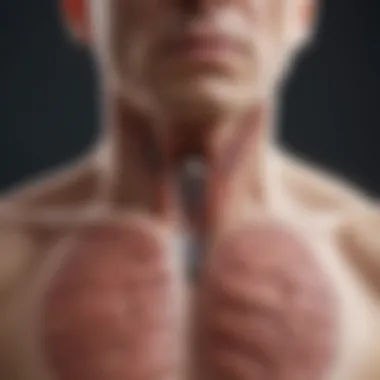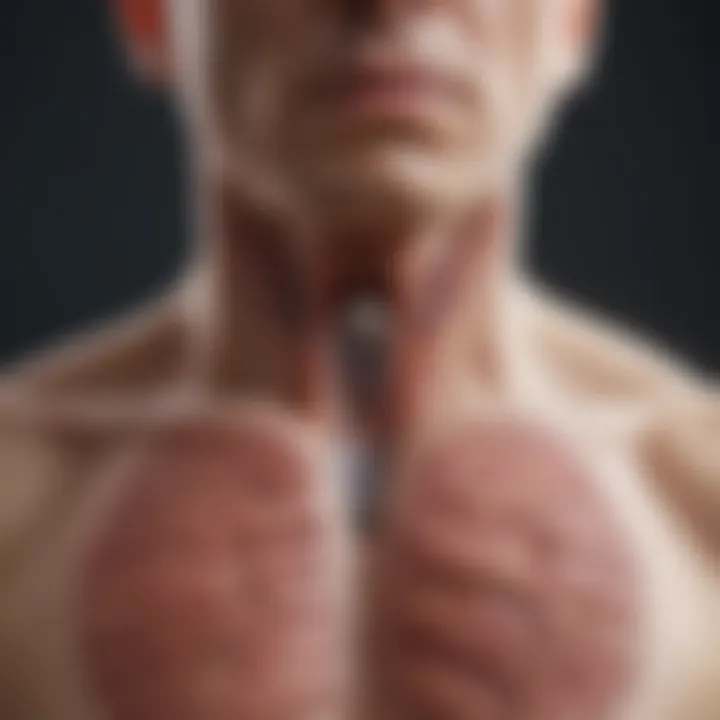Signs of Severe COPD: Symptoms and Implications


Intro
Understanding Chronic Obstructive Pulmonary Disease (COPD) is crucial, particularly when it reaches severe stages. As this condition progresses, symptoms evolve, signaling significant changes in the patient’s health. This isn't just about breathing difficulties, but affects daily functioning and overall quality of life. Knowing the signs associated with severe COPD can make a world of difference for both patients and caregivers.
COPD doesn’t just deal damage to the lungs; it can seep into the fabric of one's life, causing emotional turmoil and altering social interactions. That's why recognizing these symptoms early is like catching a lion before it pounces. The physiological and psychological implications are substantial and deserve careful consideration.
Today, we shall explore indicators of advanced COPD, their clinical significance, and why these signs aren't just mere symptoms but pivotal markers in healthcare management.
Recent Advances
Latest Discoveries
In recent years, the field of respiratory medicine has witnessed significant strides in understanding the complexities of COPD. Recent studies have delved into the genetic underpinnings of COPD, revealing that specific genetic variants can predispose individuals to a more aggressive disease progression. A key focus has shifted towards personalized medicine, which aims at tailoring treatment protocols to the individual's unique genetic makeup.
Research has indicated that early screening can dramatically improve outcomes. This highlights the importance of increasing awareness about risk factors, especially among high-risk populations like smokers or those with occupational exposures.
Technological Innovations
Emerging technologies also play a vital role in managing COPD. For instance, portable spirometers and mobile health apps have made it easier to monitor lung function in real-time. These tools enable patients to keep a closer eye on their conditions, leading to timely interventions which could stave off severe exacerbations.
The development of telemedicine platforms is another breakthrough. These services allow doctors to regularly engage with patients, offering consultations without the need for them to leave their homes. This novel approach has proven especially beneficial in rural areas where access to specialist care is often limited.
Understanding Symptoms
Recognizing and understanding the symptoms of severe COPD is half the battle won. The most pronounced indicators include:
- Increased Shortness of Breath: This can occur even during routine activities, suggesting that the lungs are struggling to deliver adequate oxygen.
- Chronic Coughing: While some may dismiss a persistent cough as a sign of a common cold, in COPD, it often signifies deeper issues, such as airway inflammation.
- Fatigue: The body's fight against the symptoms can leave patients feeling drained.
- Cyanosis: A bluish tint to the lips or fingertips is a red flag that warrants immediate attention.
"Detecting these symptoms early can drastically alter the trajectory of the illness, enhancing management strategies, and significantly ameliorating the patient's quality of life."
In light of these symptoms, the implications are vast. Not only is there a need for medical attention, but there's also a pressing requirement for lifestyle adjustments and supportive measures which can ease the daily burdens faced by COPD patients.
By fostering an understanding of what to look out for, we empower individuals and their loved ones to take charge of their health, leading to better outcomes.
Synthesis
As we wrap up our discussion on the signs associated with severe COPD, it's clear that awareness and early intervention are invaluable. Shifting the narrative from viewing this condition as a terminal diagnosis to recognizing it as manageable can illuminate paths previously thought impossible. With ongoing innovations and knowledge, a brighter horizon whispered softly among those affected by this challenging disease can be envisaged.
Prologue to COPD
Chronic Obstructive Pulmonary Disease, commonly known as COPD, is not just a medical term; it encapsulates a range of symptoms that seriously affect quality of life. This introduction aims to shed light on the various facets of COPD that one needs to grasp in order to understand the implications of its severe stage. Through recognizing the signs early, care can be tailored to mitigate suffering and enhance outcomes.
Definition and Overview
COPD is a progressive lung disease characterized primarily by limited airflow. It encompasses conditions like emphysema and chronic bronchitis, which lead to breathing difficulties over time. Patients often experience an increasing struggle with common tasks—functions we might take for granted, like climbing stairs or even walking.
In essence, COPD develops gradually, starting from mild respiratory issues and eventually escalating to a point where even the slightest effort can leave individuals gasping for breath. In many cases, this condition alone stands as a major player, contributing to an overall decline in health and vitality.
Causes and Risk Factors
The path to COPD is often paved with numerous triggers. Smoking is notorious, with about 85% of COPD cases linked to tobacco use. Other risk elements include:


- Environmental Factors: Prolonged exposure to pollutants like dust or chemical fumes can wear down lung health over years.
- Genetic Factors: Some individuals may carry genetic predispositions, wherein conditions like Alpha-1 Antitrypsin Deficiency affect lung function.
- Age and Gender: COPD is frequently seen in older adults, with increasing cases among women in light of shifting smoking trends.
Understanding these risk factors allows not only for individual awareness but also serves as guidance for preventive measures in at-risk populations.
Stages of COPD
COPD is categorized into stages based on the severity of symptoms and airflow limitation, generally described as:
- Mild: Minor impairments; might not even be realized by the patient, often mistaken for aging.
- Moderate: Symptoms become more apparent, such as increased shortness of breath during activity.
- Severe: Functional limitations emerge; frequent exacerbations complicate the clinical picture.
- Very Severe: It may require oxygen support or even lead to hospitalization.
Recognizing which stage a person is in can determine the right course of treatment and management strategies. This knowledge is crucial as it brings awareness to the significant tracking of symptoms, helping healthcare providers create effective interventions.
Understanding COPD thoroughly means understanding not just the mechanics of the disease, but also the humanity behind it. The implications of deteriorating lung function extend far beyond physical hardships, wrapping individuals and caregivers alike in a web of emotional and psychological challenges that deserve just as much attention.
Understanding Severe COPD
Grasping the concept of severe Chronic Obstructive Pulmonary Disease (COPD) is crucial for various stakeholders, including patients and healthcare professionals alike. The significance lies in recognizing how the disease progresses and impacts daily life. Severe COPD is not just a label; it marks a tipping point in the disease that requires a different approach to treatment and management.
As we examine this section, we will weigh the physiological intricacies, the complications due to the severity of symptoms, and how early detection can be instrumental in altering outcomes. Each aspect offers insight that can be leveraged for better health decisions and overall quality of life should severe COPD be part of an individual's journey.
Defining Severe COPD
Severe COPD refers to the advanced phase of the disease, characterized by persistent airflow limitation that significantly impairs the individual’s ability to breathe. The Global Initiative for Chronic Obstructive Lung Disease (GOLD) classifies COPD into stages, and severe COPD typically corresponds to stage 3 and 4.
In these stages, lung function is greatly reduced, often quantified by a Forced Expiratory Volume (FEV1) less than 50% of the predicted value. Individuals may experience wild fluctuations in their breathing capability, which can vary on a daily basis. The simple act of walking across the room may leave someone in this stage gasping for air. It's important to emphasize that this isn't just about reduced lung capacity; the body undergoes various changes.
Physiological Changes in Severe COPD
Physiological changes in severe COPD go beyond diminished lung function. As the disease progresses, the body's various systems begin to adapt or struggle in response to the limitations imposed by impaired lung capacity.
- Hyperinflation: One noticeable change is hyperinflation of the lungs, where trapped air becomes a regular nuisance, leading to prolonged expiration and even causing discomfort.
- Gas Exchange Inefficiency: The gas exchange mechanism, responsible for oxygenating the blood, becomes less efficient. This can lead to hypoxia, a state of low oxygen levels in the bloodstream, exacerbating symptoms like fatigue and cognitive issues.
- Muscle Deterioration: Coupled with these respiratory concerns, there can be significant muscle weakness, particularly in the limbs, because the body seems to draw on energy reserves to compensate for the lack of oxygen.
"Understanding the complex changes in severe COPD is essential not only for effective management but also for enhancing the life quality of patients."
In summary, understanding severe COPD encompasses much more than the disease's symptoms. It involves recognizing the constellation of physical changes that illustrate how pervasive and detrimental this condition can be. Engaging with these components is essential for effective healthcare management, thus paving the way for improved patient outcomes.
Common Signs of Severe COPD
Recognizing the common signs of severe Chronic Obstructive Pulmonary Disease (COPD) is critical not only for patients but also for their families and caregivers. These indicators are crucial to understanding the extent of the disease's impact on an individual's health and daily life. Identifying these signs can lead to earlier intervention, better management strategies, and ultimately improve quality of life.
In this section, we’ll explore five key symptoms that often manifest in individuals with advanced COPD. Delving into these symptoms provides insight into their implications and helps raise awareness about the condition.
Excessive Shortness of Breath
Shortness of breath is one of the hallmark symptoms of severe COPD. Patients often find themselves gasping for air even during minimal exertion, like walking to the bathroom or carrying groceries. This excessive dyspnea originates from the lungs' inability to process oxygen effectively due to irreversible damage to the air sacs and airways.
- Functional Impairment: Patients struggling with shortness of breath may avoid physical activities, leading to a sedentary lifestyle that exacerbates overall health.
- Psychological Impact: The fear of breathlessness can result in anxiety, creating a cycle where anxiety further exacerbates the breathing difficulty.
"Shortness of breath is not merely a physical limitation; it can affect daily interactions and diminish overall life satisfaction."
Frequent Respiratory Infections
Individuals with severe COPD are more prone to respiratory infections, a condition arising from compromised lung function and mucus clearance. This vulnerability can lead to exacerbated symptoms and increased hospital visits.


- Types of Infections: Pneumonia and bronchitis are particularly common. These infections can complicate the COPD management process and signify a deterioration in lung health.
- Monitoring and Management: Regular medical check-ups become vital as early detection and treatment of respiratory infections can significantly mitigate their impact.
Chronic Cough with Sputum
A persistent cough, often accompanied by sputum production, is a prevalent sign of severe COPD. This chronic cough typically results from inflammation and irritation of the airway due to mucus buildup.
- Expectoration: The color and consistency of sputum can indicate infection or worsening lung condition. For instance, yellow or green sputum may suggest an infection that requires immediate attention.
- Lifestyle Interference: Chronic cough can disrupt daily routines and affect sleep, ultimately diminishing one’s quality of life.
Fatigue and Weakness
Fatigue is another common sign that severely impacts individuals with COPD. The constant struggle for air and the body's effort to breathe can drain energy reserves.
- Physical Decrease: Patients might experience muscle weakness as physical activity becomes overwhelming. This can lead to greater limitations in daily life, making simple tasks feel like climbing Mount Everest.
- Cognitive Effects: Severe fatigue can also impair cognitive function, making it harder to concentrate or make decisions, adding another layer of challenge for those affected.
Cyanosis in Extremities
Cyanosis refers to a bluish discoloration of the skin, particularly in the extremities, occurring when oxygen levels in the blood are insufficient. In severe COPD, this can happen when the lungs are not transferring oxygen adequately.
- Indicator of Severity: This symptom often acts as a clear warning sign that the body is not receiving enough oxygen, necessitating urgent medical evaluation.
- Pervasive Concerns: Patients might notice a change in their fingers or lips, which can be distressing and emphasizes the critical need for proper medical management.
Understanding these common signs is essential for anyone touched by COPD. Whether it’s a patient monitoring their symptoms or a caregiver providing support, recognizing these signals can fundamentally alter the trajectory of care and quality of life.
Psychological Impacts of Severe COPD
The psychological ramifications of Severe Chronic Obstructive Pulmonary Disease (COPD) cannot be overstated. While the physical symptoms often dominate conversations, it is crucial to recognize that the emotional and mental well-being of individuals suffering from this condition are closely intertwined with their overall health. The burden of breathing difficulties, the unpredictability of flare-ups, and limitations in activities can give rise to profound feelings of anxiety and depression. This aspect deserves a spotlight, as understanding these psychological impacts can guide healthcare providers and families in delivering holistic care that addresses both mind and body.
Anxiety and Depression
Individuals facing severe COPD frequently report escalating levels of anxiety and depression, an understandable reaction to their deteriorating health status. As their capacity for physical activity declines, they may become increasingly concerned about their independence and the quality of life that awaits them. Feeling breathless even during simple tasks can provoke a panic response, making those moments feel insurmountable.
Some key points about this connection include:
- Fear of Exacerbations: The unpredictable nature of COPD can lead patients to live in fear of sudden worsening symptoms. This constant worry often translates to anxiety, making everyday situations feel daunting.
- Isolation: Many feel cut off from social interactions due to their condition. Reduced ability to engage in activities they once enjoyed can lead to loneliness.
- Cognitive Decline: Depression can cloud judgment and affect memory, further hindering the individual's ability to cope with their illness, creating a vicious cycle.
Addressing the mental health component is essential for improving life quality. Treatments may include psychotherapy, support groups, or medications, but each individual’s response varies.
"Living with COPD is like carrying an invisible weight that only those who experience it truly understand."
Quality of Life Considerations
Quality of life is a multifaceted concept that encompasses a person's physical health, psychological state, level of independence, and social relations. For individuals with severe COPD, defining and preserving quality of life can become complex.
Some considerations include:
- Physical Limitations: Individuals often face challenges in performing daily activities. This can affect not just health but also self-esteem and social inclusivity.
- Chronic Pain and Discomfort: Frequent coughing and shortness of breath create discomfort, which can lead to further mental distress. A constant awareness of their health condition can overshadow happier or fulfilling moments.
- Need for Support Systems: Solid support systems play a pivotal role in mitigating feelings of isolation. Engaging with family and friends can provide emotional sustenance, helping individuals navigate their journey with COPD more smoothly.
In summary, understanding the psychological impacts of severe COPD is as critical as addressing its physical symptoms. Acknowledging and addressing mental health challenges can lead to better treatment outcomes, ensuring comprehensive care that attends to all aspects of a patient’s life.
Healthcare Management of Severe COPD
Managing severe COPD is paramount not just for medical staff but also for patients and their families. Recognizing the intricate interplay of symptoms and implications allows for a more structured approach to healthcare. With a proper management plan, patients may experience a marked improvement in quality of life.


Medication and Therapies
Medications play a central role in managing COPD and can contribute significantly to controlling symptoms. Bronchodilators, such as salbutamol and ipratropium bromide, relax the muscles around the airways, making breathing easier. Meanwhile, inhaled corticosteroids help reduce inflammation, which is particularly important during flare-ups.
"The key to effective management lies in personalized treatment��—what works for one may not for another."
Moreover, if symptoms progress, specialists might introduce oral medications like theophylline, which aids in opening air passages. There's also the option of oxygen therapy for cases where supplemental oxygen is needed to support daily activities. Regular follow-ups ensure that any adjustments can be made in a timely manner, optimizing the medication regimen.
Importance of Rehabilitation
Rehabilitation often gets the short end of the stick in discussions around COPD. Yet, its value cannot be overstated. Pulmonary rehabilitation programs aim to improve physical endurance and overall well-being by offering tailored exercise regimens, educational support, and nutritional guidance.
It's not just about pushing the body physically; it addresses the psychological aspects too. Many patients feel isolated due to their condition. Group therapies reveal that they aren’t alone and provide a platform for sharing experiences and coping strategies.
In essence, rehabilitation fosters a sense of control over their health, helping to combat the feelings of helplessness that can sometimes accompany severe COPD.
Palliative Care Options
Palliative care is frequently misunderstood as a last resort. Yet, integrating it early in the COPD journey can drastically enhance a patient's quality of life. Focused on alleviating suffering rather than curing the illness, palliative care addresses the physical, emotional, and spiritual distress associated with severe COPD.
Pain management, assistance with symptoms like breathlessness, and psychological support play critical roles. Constructing a care plan that aligns with a patient's values and preferences helps everyone involved navigate this challenging path with dignity. Families, too, benefit as care teams can support their needs, allowing them to focus more on the important moments together.
Future Directions in COPD Research
Chronic Obstructive Pulmonary Disease (COPD) remains a significant challenge within the healthcare community. As understanding of this debilitating illness deepens, the future directions in COPD research hold promise for better management options, improved patient outcomes, and an enhanced quality of life. This section will delve into crucial innovations in treatment and give an overview of ongoing clinical trials that could shape the landscape of COPD care.
Innovations in Treatment
In the realm of COPD, treatment approaches are evolving rapidly. Here are some notable innovations that give hope to patients:
- Biological Therapies: Recently, biologics designed to target specific inflammatory pathways have shown promise in reducing exacerbations. Such therapies could potentially revolutionize care for those with irregular responses to conventional medications.
- Advanced Delivery Systems: New inhalers equipped with smart technology are being developed. These devices not only allow for precise medication delivery but also provide real-time feedback to patients and healthcare providers, ensuring patients are using medications correctly.
- Gene Therapy: Although still in its infancy, gene therapy represents an exciting frontier in treating COPD. By targeting the underlying genetic factors, this approach aims to alter the disease’s trajectory at a molecular level.
- Telemedicine: The increase in telehealth services has opened doors for consistent monitoring of patients with COPD, allowing healthcare professionals to assess symptoms remotely, adjust treatment plans effectively, and intervene quickly when necessary.
These innovations could significantly change how COPD is managed, enabling tailored treatment strategies that address individual needs more effectively.
Ongoing Clinical Trials
To further enhance patient outcomes in COPD, numerous clinical trials are underway. Each trial focuses on different aspects of care, pushing the envelope on what is currently known. Some key areas of research include:
- New Medications: Trials evaluating the efficacy of novel bronchodilators and anti-inflammatory agents aim to benchmark their performance against current standards. This could lead to discovering treatments that provide superior relief from symptoms.
- Combination Therapies: Investigating the effects of various drug combinations offers a promising avenue. Combination therapies might work synergistically, enhancing effectiveness while minimizing side effects.
- Lifestyle Interventions: Ongoing research also includes exploring how lifestyle changes, like diet and exercise regimens, can influence disease progression. Understanding the impact of these factors is vital for providing a holistic approach to COPD management.
- Patient-Centric Studies: Trials focusing on quality of life, symptom management, and psychological support are gaining traction. These studies emphasize that managing COPD is not just about physical symptoms but also addressing the mental and emotional health of patients.
Advancements in clinical trials are essential as they not only test new hypotheses but also pave the way for evidence-based practices in COPD management.
"The future of COPD management hinges on both innovation and robust research, ensuring that patient care continues to improve in meaningful ways."
As the research landscape continually evolves, it’s crucial for healthcare stakeholders to remain engaged and informed. It is the collective responsibility of researchers, clinicians, and patients alike to advocate for and contribute to forward-thinking initiatives that promise to alter the course of this disease.
End
In contemplating the signs of severe Chronic Obstructive Pulmonary Disease (COPD), it’s essential to appreciate the delicate balance between early recognition and subsequent healthcare management. The implications extend beyond the mere presentation of symptoms; they touch the very essence of how individuals with severe COPD experience life. Not only does this disease affect physical health, but it also entwines itself with psychological well-being, creating a multifaceted challenge that requires nuanced understanding.
The importance of drawing attention to the signs of severe COPD cannot be overstated. Increased awareness enables timely interventions and can significantly impact the patient’s quality of life. Symptoms like excessive shortness of breath or frequent respiratory infections could appear as just part of routine aging or lifestyle issues but hold deeper significance when viewed through the lens of COPD. This highlights why detailed knowledge of these indicators is invaluable for students, researchers, healthcare professionals, and educators alike.
Furthermore, recognizing these signs early sets the stage for better management strategies. By addressing issues promptly, patients can avoid undue suffering and can receive tailored care that aligns with their unique circumstances.
"The clearer we understand the signs, the sharper our responses can be."
This aformentioned point lays the groundwork for a proactive approach to the disease, underscoring the need for systemic changes in healthcare practices and mixed treatment methods.
Emphasizing the interconnectedness of physical and psychological factors within the context of severe COPD can reveal the inherent complexity of living with this condition, urging us to foster a compassionate and informed approach to treatment.















